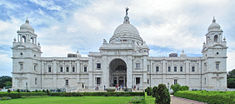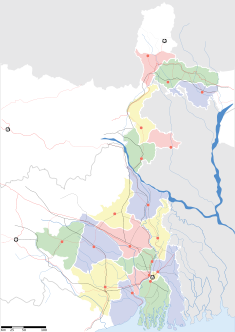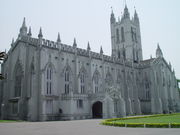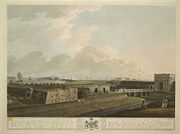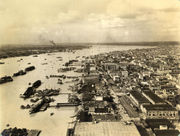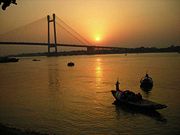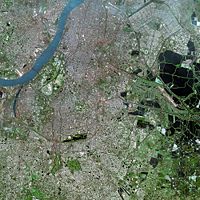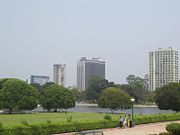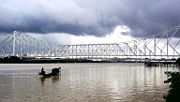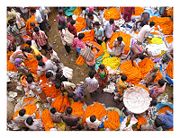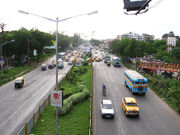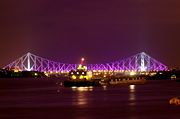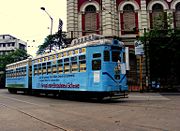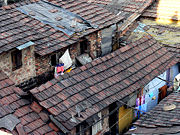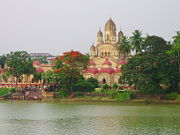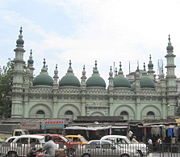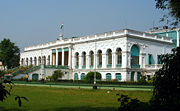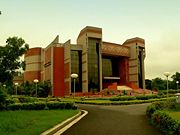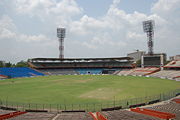Kolkata
2008/9 Schools Wikipedia Selection. Related subjects: Asia; Asian Cities
| ?Kolkata West Bengal • India |
|
|
|
|
|
|
|
| Coordinates: | |
| Time zone | IST ( UTC+5:30) |
| Area • Elevation |
1,500 km² (579 sq mi) • 9 m (30 ft) |
| District(s) | Calcutta † |
| Population • Density • Metro |
4,580,544 (2001) • 9,920 /km² (25,693 /sq mi) • 14,681,589 |
| Language(s) | Bengali, English, Hindi, Urdu |
| Mayor | Bikash Ranjan Bhattacharya |
| Codes • Pincode • Telephone |
• 700 xxx • +91 (33) |
| Website: www.kolkatamycity.com | |
| † The Kolkata urban agglomeration also includes portions of North 24 Parganas and South 24 Parganas districts. | |
Coordinates:
Kolkata (Bengali: কলকাতা), IPA: ['kolkat̪a], formerly Calcutta , is the capital of the Indian state of West Bengal. It is located in eastern India on the east bank of the River Hooghly. The city has a population of more than 4.6 million, with an extended metropolitan population of over fourteen million, making it the third-largest urban agglomeration and the fourth-largest city in India.
Kolkata served as the capital of India during the British Raj until 1911. Once the centre of modern education, science, culture and politics in India, Kolkata witnessed economic stagnation in the years following India's independence in 1947. However, since the year 2000, economic rejuvenation has led to a spurt in the city's growth. Like the other metropolitan cities of India, Kolkata continues to struggle with urbanisation problems like poverty, pollution and traffic congestion.
Kolkata is noted for its revolutionary history, ranging from the Indian struggle for independence to the leftist and trade union movements.
Name
Probably based on Kalikata, the name of one of the three villages ( Kalikata, Sutanuti, Gobindapur) in the area before the arrival of the British. "Kalikata", in turn, is believed to be an anglicised version of Kalikshetra (কালীক্ষেত্র, "Land of [the goddess] Kālī"). Alternatively, the name may have been derived from the Bengali term kilkila ("flat area"). Again, the name may have its origin in the indigenous term for a natural canal, Khal, followed by Katta (which may mean dug). While the city's name was always pronounced "Kolkata" in the local Bengali language, its official English name was only changed from "Calcutta" to "Kolkata" in 2001, reflecting the Bengali pronunciation. Some view this as a move to erase the legacy of British rule.
History
The discovery of the nearby Chandraketugarh, an archaeological site, provides evidence that the area has been inhabited for over two millennia. The city's documented history, however, begins with the arrival of the British East India Company in 1690, when the Company was consolidating its trade business in Bengal. Job Charnock, an administrator with the Company was traditionally credited as the founder of this city. However, recently experts have endorsed the view that Charnock was not the founder of the city.
In 1702, the British completed the construction of old Fort William, which was used to station its troops and as a regional base. Kolkata (then Calcutta) was declared a Presidency City, and later became the headquarters of the Bengal Presidency. Faced with frequent skirmishes with French forces, in 1756 the British began to upgrade their fortifications. When protests against the militarisation by the Nawab of Bengal Siraj-Ud-Daulah went unheeded he attacked and captured Fort William, leading to the infamous Black Hole incident. A force of Company sepoys and British troops led by Robert Clive recaptured the city the following year. Kolkata was named the capital of British India in 1772, although the capital shifted to the hilly town of Shimla during the summer months every year, starting from the year 1864. It was during this period that the marshes surrounding the city were drained and the government area was laid out along the banks of the Hooghly River. Richard Wellesley, the Governor General between 1797–1805, was largely responsible for the growth of the city and its public architecture which led to the description of Kolkata as "The City of Palaces". The city was a centre of the British East India Company's opium trade during the 18th and 19th century; locally produced opium was sold at auction in Kolkata, to be shipped to China.
By the early 19th century, Kolkata was split into two distinct areas—one British (known as the White Town), the other Indian (known as Black Town). Even at the time, the poverty of the 'Black Town' shanties was considered shocking. The city underwent rapid industrial growth from the 1850s, especially in the textile and jute sectors; this caused a massive investment in infrastructure projects like railroads and telegraph by British government. The coalescence of British and Indian culture resulted in the emergence of a new Babu class of urbane Indians — whose members were often bureaucrats, professionals, read newspapers, were Anglophiles, and usually belonged to upper- caste Hindu communities. Throughout the nineteenth century, a socio-cultural reform, often referred to as the Bengal Renaissance resulted in the general uplifting of the people. In 1883, Surendranath Banerjee organised a national conference — the first of its kind in nineteenth century India. Gradually Kolkata became a centre of the Indian independence movement, especially revolutionary organisations. The 1905 Partition of Bengal on communal grounds resulted in widespread public agitation and the boycott of British goods ( Swadeshi movement). These activities, along with the administratively disadvantageous location of Kolkata in the eastern fringes of India, prompted the British to move the capital to New Delhi in 1911.
The city's port was bombed twice by the Japanese during World War II. As food stocks were being diverted to feed Allied troops, millions starved to death during the Bengal famine of 1943. In 1946, demands for the creation of a Muslim state led to large-scale communal violence resulting in the deaths of over 2,000 people. The partition of India also created intense violence and a shift in demographics — large numbers of Muslims left for East Pakistan, while hundreds of thousands of Hindus fled into the city.
Over the 1960s and 1970s, severe power shortages, strikes and a violent Marxist-Maoist movement — the Naxalites — damaged much of the city's infrastructure, leading to an economic stagnation. In 1971, war between India and Pakistan led to the mass influx of thousands of refugees into Kolkata resulting in a massive strain on its infrastructure. In the mid-1980s, Mumbai overtook Kolkata as India's most populous city. Kolkata has been a strong base of Indian communism as West Bengal has been ruled by the CPI(M) dominated Left Front for three decades now — the world's longest-running democratically-elected Communist government. The city's economic recovery gathered momentum after economic reforms in India introduced by the central government in the mid-1990s. Since 2000, Information Technology (IT) services revitalized the city’s stagnant economy. The city is also experiencing a growth in the manufacturing sector.
Geography
Kolkata is located in eastern India at in the Ganges Delta at an elevation ranging between 1.5 m (5 ft) to 9 m (30 ft). It is spread linearly along the banks of the River Hooghly in a north-south direction. Much of the city was originally a vast wetland, reclaimed over the decades to accommodate the city's burgeoning population. The remaining wetland, known as East Calcutta Wetlands has been designated a "wetland of international importance" under the Ramsar Convention.
Like the most of the Indo-Gangetic plains, the predominant soil type is alluvial. Quaternary sediments consisting of clay, silt, various grades of sand and gravel underlie the city. These sediments are sandwiched between two clay beds, the lower one at depths between 250 m (820 ft) and 650 m (2,133 ft) and the upper one ranging between 10 m (33 ft) and 40 m (131 ft) in thickness. According to the Bureau of Indian Standards, the town falls under seismic zone-III, in a scale of I to V (in order of increasing proneness to earthquakes) while the wind and cyclone zoning is "very high damage risk", according to UNDP report.
Urban structure
Kolkata city, under the jurisdiction of the Kolkata Municipal Corporation (KMC), has an area of 185 km² (71 sq mi). The Kolkata urban agglomeration, however, has continuously expanded and as of 2006, the urban agglomeration ( Kolkata Metropolitan Area) is spread over 1,750 km² (676 sq mi), and comprises 157 postal areas. The urban agglomeration is formally administered by several local governments including 38 local municipalities. The urban agglomeration comprises 72 cities and 527 towns and villages. The suburban areas of Kolkata metropolitan district incorporates parts of the districts North 24 Parganas, South 24 Parganas, Howrah, Hooghly and Nadia.
The east-to-west dimension of the proper city is narrow, stretching from the Hooghly River in the west to roughly the Eastern Metropolitan Bypass in the east, a span of barely 5 km (3.1 mi)–6 km (3.7 mi). The north-south expansion is roughly divided into North, Central and South Kolkata. North Kolkata locality is the oldest part of the city, with 19th century architecture and narrow alleyways. South Kolkata grew mostly after independence and consists of well-to-do localities. The Salt Lake City (Bidhan Nagar) area to the northeast of the city is a planned section of Kolkata. Rajarhat, also called New Town, is a planned township being developed on the north-eastern fringes of the city.
Central Kolkata houses the central business district around the B. B. D. Bagh area. The government secretariat, General Post Office, High Court, Lalbazar Police HQs and several other government and private offices are located here. The Maidan is a large open field in the heart of the city where several sporting events and public meetings are held. Several companies have set up their offices around the area south of Park Street which has become a secondary central business district.
Climate
Kolkata has a tropical wet-and-dry climate ( Koppen climate classification Aw). The annual mean temperature is 26.8 °C (80.2 °F); monthly mean temperatures range from 19 °C (66.2 °F) to 30 °C (86.0 °F). Summers are hot and humid with temperatures in the low 30's and during dry spells the maximum temperatures often exceed 40 °C (104 °F) during May and June. Winter tends to last for only about two and a half months, with seasonal lows dipping to 9 °C – 11 °C (54 °F – 57 °F) between December and January. The highest recorded temperature is 43.9 °C (111.0 °F) and the lowest is 5 °C (41.0 °F).On an average, May is the hottest month with daily temperatures ranging from a low of 27 °C (80.6 °F) to a maximum of 37 °C (98.6 °F),while January the coldest month has temperatures varying from a low of 12 °C (53.6 °F) to a maximum of 23 °C (73.4 °F). Often during early summer, dusty squalls followed by spells of thunderstorm or hailstorms and heavy rains cum ice sleets lash the city, bringing relief from the humid heat. These thunderstorms are convective in nature, and is locally known as Kal baisakhi (কালবৈশাখী, Nor'westers).
Rains brought by the Bay of Bengal branch of South-West monsoon lash the city between June and September and supplies the city with most of its annual rainfall of 1,582 mm (62 in). The highest rainfall occurs during the monsoon in August—306 mm (12 in)). The city receives 2,528 hours of sunshine per annum, with the maximum sunlight occurring in March. Pollution is a major concern in Kolkata, and the Suspended Particulate Matter (SPM) level is high when compared to other major cities of India, leading to regular smog and haze. Severe air pollution in the city has caused rise in pollution-related respiratory ailments such as lung cancer.
Economy
Kolkata is the main business, commercial and financial hub of eastern India and the northeastern states. It is home to the Calcutta Stock Exchange — India's second-largest bourse. It is also a major commercial and military port, and the only city in the region to have an international airport. Once India's leading city and Capital, Kolkata experienced a steady economic decline in the years following India's independence due to the prevalent unstabilised political condition and rise in trade-unionism supported by left-wing parties. Between the 1960s to the mid 1990s, flight of capital was enormous as many large factories were closed or downsized and businesses relocated. The lack of capital and resources coupled with a worldwide glut in demand in the city's traditional industries (e.g. jute) added to the depressed state of the city's economy. The liberalisation of the Indian economy in the 1990s along with the election of a new reformist Chief Minister, Buddhadeb Bhattacharya have resulted in the improvement of the city's fortunes.
Until recently, flexible production had always been the norm in Kolkata, and the informal sector has comprised more than 40% of the labour force. For example, roadside hawkers generated business worth Rs. 8,772 crore (around 2 billion U.S. dollars) in 2005. State and federal government employees make up a large percentage of the city's workforce. The city has a large unskilled and semi-skilled labour population, along with other blue-collar and knowledge workers. Kolkata's economic revival was led largely by IT services, with the IT sector growing at 70% yearly — twice that of the national average. In recent years there has been a surge of investments in the housing infrastructure sector with several new projects coming up in the city. Kolkata is home to many industrial units operated by large Indian corporations with products ranging from electronics to jute. Some notable companies headquartered in Kolkata include ITC Limited, Bata India, Birla Corporation, Coal India Limited, Damodar Valley Corporation, United Bank of India, UCO Bank and Allahabad Bank. Recently, various events like adoption of "Look East" policy by the government of India, opening of the Nathu La Pass in Sikkim as a border trade-route with China and immense interest in the South East Asian countries to enter the Indian market and invest have put Kolkata in an advantageous position.
Civic administration
The government of Kolkata, that is, of the area within which the Kolkata Municipal Corporation (KMC) functions, involves at least the following authorities: the KMC itself, the Kolkata Collector, the Kolkata Police, the Collector / District Magistrate (DM) of South 24 Parganas District, and the Superintendent of Police (SP) of South 24 Parganas District.
The Kolkata Collector collects land revenues within a relatively small part of the area within which the KMC functions; the Kolkata Police performs police functions in the Collector's area and also an additional area; and the KMC provides services such as water in the Kolkata Police's entire area and also an additional area.
In the Kolkata Police's "additional area", as it has been called here (this is not an official term), revenue collection is performed by the Collector/DM of South 24 Parganas District. And in the KMC's "additional area", revenue collection is performed by the Collector/DM of South 24 Parganas District, and police functions are performed by the SP of South 24 Parganas District (who is under the Collector/DM of that district).
The Kolkata Collector's area is known as Kolkata District. The Kolkata Police's entire area comprises eighty-six wards of the KMC in their entirety, plus most of another six KMC wards., The KMC's entire area comprises all 141 wards of the KMC. "City" in relation to Kolkata is not an official term; when used, it normally refers to the KMC area.
It may seem paradoxical that the area of a district should be a subset of one urban area, since normally a district contains numerous urban areas as well as rural areas. This and the various other complications of Kolkata's government are mostly explained by the fact that Kolkata's gradual urban sprawl had somehow to be accommodated to existing political boundaries.
In talking about Kolkata, it may be necessary to define one's terms in one of five ways, listed here in ascending order as to the size of the area: 1) Kolkata District, 2) the Kolkata Police area, 3) the KMC area ("Kolkata city"), 4) "Greater Kolkata", which adds to the KMC area a few areas just adjacent to it, and 5) the Kolkata Metropolitan Area. (See the section "Urban structure" above.)
The Kolkata Municipal Corporation (KMC), (formerly the Calcutta Municipal Corporation), established in 1876, is responsible for the civic maintenance and infrastructure of Kolkata. The city is divided into 141 administrative wards that are grouped into 15 boroughs. Each of these wards elects a councillor to the KMC. Each borough has a committee consisting of the councillors elected from the respective wards of the borough. The Corporation, through the borough committees, maintains government-aided schools, hospitals and municipal markets and partakes in urban planning and road maintenance. The corporation as the apex body discharges its function through the Mayor-in-Council, consisting of a mayor, assisted by a deputy mayor, and ten other elected members of the KMC. The mayor is responsible for the overall functioning of the KMC and has a tenure of five-years. At present, the CPI(M) led Left Front holds the power in KMC.
The city also has an apolitical titular post, that of the Sheriff of Kolkata. The Sheriff presides over various city-related functions and conferences. Another ancillary civic body is the Kolkata Metropolitan Development Authority (KMDA) responsible for the statutory planning and development of the Kolkata Metropolitan Area (KMA). The KMA includes a large suburban hinterland around the urban centres of Kolkata.
As the capital of the state and the seat of the Government of West Bengal, Kolkata houses the West Bengal Legislative Assembly, the Secretariat ( Writers' Building) and the Calcutta High Court. Kolkata also has lower courts; the Small Causes Court for civil matters, and the Sessions Court for criminal cases. The Kolkata Police, headed by the Police Commissioner, comes under the West Bengal Home Ministry. The city is administratively divided into several police-zones subdivided into 59 local police stations—48 of them under the Kolkata Police and 11 of them (counting two outposts) under the Superintendent of Police of South 24 Parganas District. The city elects 3 representatives to the Lok Sabha (India's lower house) and 21 representatives to the state Legislative Assembly.
Transport
Public transport is provided by the Kolkata suburban railway, the Kolkata Metro, trams and buses. The suburban network is extensive and extends into the distant suburbs. The Kolkata Metro, run by the Indian Railways, is the oldest underground system in India. It runs parallel to the River Hooghly and spans the north-south length of the city covering a distance of 16.45 km. Buses are the preferred mode of transport and are run by both government agencies and private operators. Kolkata is India's only city to have a tram network, operated by Calcutta Tramways Company. The slow-moving tram services are restricted to certain areas of the city. Water-logging due to heavy rains during the monsoon sometimes interrupts the public transport.
Hired forms of mechanised transport include the yellow metered taxis, while auto rickshaws ply in specific routes. Almost all the taxis in Kolkata are Ambassadors. This is unlike most other cities where Tata Indica or Fiats are more common. In some areas of the city, cycle rickshaws and hand-pulled rickshaws are also patronised by the public for short distances. Private owned vehicles are less in number and usage compared to other major cities due to the abundance in both variety and number of public vehicles. However, the city witnessed a steady increase in the number of registered vehicles; 2002 data showed an increase of 44% over a period of seven years. The road space (matched with population density) in the city is only 6%, compared to 23% in Delhi and 17% in Mumbai, creating major traffic problems. Kolkata Metro Railway and a number of new roads and flyovers have decongested the traffic to some extent.
Kolkata has two major long distance railway stations at Howrah Station and Sealdah. A third station named Kolkata has been launched in early 2006. The city is the headquarters of two divisions of the Indian Railways — Eastern Railway and South Eastern Railway.
The city's sole airport, the Netaji Subhash Chandra Bose International Airport at Dum Dum to the north of the city, operates both domestic and international flights. Kolkata is also a major riverport in eastern India. The Kolkata Port Trust manages both the Kolkata docks and the Haldia docks. There are passenger service to Port Blair in the Andaman and Nicobar Islands and cargo ship service to various ports in India and abroad, operated by the Shipping Corporation of India. Also there are ferry services connecting Kolkata with its twin city of Howrah.
Demographics
Residents of Kolkata are called Calcuttans. As of 2001, Kolkata city had a population of 4,580,544, while the urban agglomeration had a population of 13,216,546. The sex ratio is 828 females per 1000 males – which is lower than the national average, because many working males come from rural areas, where they leave behind their families. Kolkata's literacy rate of 80.86% exceeds the all-India average of 64.8%. Kolkata Municipal Corporation area has registered a growth rate of 4.1%, which is the lowest among the million-plus cities in India.
Bengalis comprise the majority of Kolkata's population (55%), with Marwaris, Oriya and Bihari communities forming a large portion of the minorities (20%). Some of Kolkata's notable communities include Chinese, Tamils, nepalis, Telugus, Assamese, Gujaratis, Anglo-Indians, Armenians, Tibetans, Maharashtrians, Punjabis, Malayalees and Parsis. Major languages spoken in Kolkata are Bengali, Hindi, English, Oriya, and Bhojpuri.
According to the 2001 census, 77.68% of the population in Kolkata is Hindu, 20.27% Muslim, 0.88% Christian and 0.75% Jains. Other minorities such as Sikhs, Buddhist, Jews and Zoroastrian constitute the rest of the city's population. 1.5 million people, who constitute about a third of the city's population, live in 2,011 registered and 3,500 unregistered (occupied by squatters) slums.
Kolkata reported 67.6% of total Special and Local Laws (SLL) crimes registered in 35 Indian mega cities in 2004. Kolkata police district registered 10,757 IPC cases in 2004, which was 10th highest in the country. The crime rate in the city was 71 per 100,000 against the national rate of 167.7 in 2006, which is the lowest among all the mega cities in India. Kolkata's Sonagachi area, with more than 10,000 sex workers, is one of Asia's largest red-light districts.
Culture
Kolkata has long been known for its literary, artistic and revolutionary heritage. As the former capital of India, Kolkata was the birthplace of modern Indian literary and artistic thought. Kolkatans tend to have a special appreciation for art and literature; its tradition of welcoming new talent has made it a "city of furious creative energy".
A characteristic feature of Kolkata is the para or neighbourhoods having a strong sense of community. Typically, every para has its own community club with a clubroom and often, a playing field. People here habitually indulge in adda or leisurely chat, and these adda sessions are often a form of freestyle intellectual conversation. The city has a tradition of political graffiti depicting everything from outrageous slander to witty banter and limericks, caricatures to propaganda.
Kolkata has many buildings adorned with Gothic, Baroque, Roman, Oriental and Indo-Islamic (including Mughal) motifs. Several major buildings of the Colonial period are well maintained and have been declared "heritage structures", while others are in various stages of decay. Established in 1814, the Indian Museum is the oldest museum in Asia and houses vast collection of Indian natural history and Indian art. The Victoria Memorial, one of the major tourist attractions in Kolkata, has a museum documenting the city's history. The National Library of India is India's leading public library. Academy of Fine Arts and other art galleries hold regular art exhibitions.
The city has a tradition of dramas in the form of jatra (a kind of folk-theatre), theatres and Group Theatres. Mainstream Hindi films are popular, as are films from the Bengali cinema industry, dubbed "Tollywood". Tollygunj in Kolkata is the location of Bengali movie studios and the name "Tollywood" (similar as Hollywood, USA) is derived from that name. Its long tradition of filmmaking includes acclaimed directors such as Satyajit Ray, Mrinal Sen, Tapan Sinha and Ritwik Ghatak to contemporary directors such as Aparna Sen and Rituparno Ghosh.
Key elements of Kolkata's cuisine include rice and macher jhol (fish curry), with rasagolla, sandesh and mishti doi (sweet yoghurt) as dessert. Bengal's vast repertoire of fish-based dishes includes various hilsa preparations (a favorite among Bengalis). Street foods such as beguni (fried battered eggplant slices), kati roll (flatbread roll with vegetable or chicken, mutton, or egg stuffing), phuchka (deep fried crêpe with tamarind and lentil sauce) and Chinese food from China Town in the eastern parts of the city are quite popular.
Bengali women commonly wear the shaŗi as per tradition and global/western outfits. Among men, western dressing has greater acceptance. Men also wear panjabi with dhuti, which had erupted as a trend during the renaissance period of Bengal. Kolkatans are becoming brand conscious, which is attracting global brands to set up base here.
Durga Puja is the most important and the most glamourous event in Kolkata. Other notable festivals include Jagaddhatri Puja, Diwali, Eid, Holi, Christmas, poila boishak (new year), Saraswati puja, Rath Yatra and Poush parbon (harvest festival). Some of the cultural festivals are Kolkata Book Fair, Dover Lane music festival, Kolkata Film Festival and National Theatre Festival.
The city is also noted for its appreciation of Indian classical music as well as Bengali folk music such as baul. In the nineteenth and twentieth century, Bengali literature was modernized in the works of authors such as Bankim Chandra Chattopadhyay, Michael Madhusudan Dutt, Rabindranath Tagore, Kazi Nazrul Islam and Sharat Chandra Chattopadhyay. The rich literary tradition set by these authors has been carried forward in the works of Jibanananda Das, Bibhutibhushan Bandopadhyay, Tarashankar Bandopadhyay, Manik Bandopadhyay, Shirshendu Mukhopadhyay, Buddhadeb Guha, Samaresh Majumdar, Sanjeev Chattopadhyay and Sunil Gangopadhyay among others.
From the early 1990s, there has been an emergence and popularisation of new genres of music, including fusions of Baul and Jazz by several Bangla bands, as well as the emergence of what has been called Jeebonmukhi Gaan (a modern genre based on realism) by artists like Kabir Suman, Anjan Dutta, Nachiketa and bands like Chandrabindoo, Cactus, Lakkhichhara, Fossils and Insomnia.
Kolkata is sister city to Long Beach, California in the United States.
Education
Kolkata's schools are either run by the state government or by private (many of which are religious) organisations. Schools mainly use English or Bengali as the medium of instruction, though Hindi and Urdu are also used. The schools are affiliated with the Indian Certificate of Secondary Education (ICSE), the Central Board for Secondary Education (CBSE), A-Level's (British Curriculum) or the West Bengal Board of Secondary Education. Under the 10+2+3 plan, after completing their secondary education, students typically enroll in a 2 year junior college (also known as a pre-university) or in schools with a higher secondary facility affiliated with West Bengal Council of Higher Secondary Education. Students usually choose from one of three streams — liberal arts, commerce, or science, though vocational streams are also available. Upon completing the required coursework, students may enrol in general or professional degree programmes.
Kolkata has nine universities; numerous colleges are affiliated to these nine or to other universities located outside of Kolkata. The University of Calcutta (founded in 1857) has more than 200 affiliated colleges. Bengal Engineering & Science University, West Bengal University of Technology and Jadavpur University are notable engineering universities. Calcutta Medical College is the first institution teaching modern medicine in Asia. Other notable institutions are Presidency College and St. Xavier's College. Some institutions of national importance are the Asiatic Society, Bose Institute, the Indian Statistical Institute, the Indian Institute of Management, the Indian Association for the Cultivation of Science, the Variable Energy Cyclotron Centre, the Saha Institute of Nuclear Physics, the Centre for Studies in Social Sciences, Calcutta, the West Bengal National University of Juridical Sciences, the Marine Engineering and Research Institute , the Indian Institute of Science Education and Research , the S.N. Bose National Centre for Basic Sciences and the Indian Institute of Social Welfare and Business Management.
Sports
Cricket and football (soccer) are popular sports in the city. Kolkata is one of the major centres of football activity in India. Kolkata is known as Mecca of Indian Football. Calcutta Football League, which started in 1898, is the oldest football league in Asia. Kolkata is home of top national Sports Clubs such as Mohun Bagan AC, Mohammedan Sporting Club and East Bengal, who are among the top football clubs of India. Mohun Bagan AC, one of the oldest football clubs in Asia, is the only club to be entitled 'National Club of India' whereas East Bengal stands as the most successful of all the Indian football clubs in international arena. Kolkata is also home to Shahrukh Khan-owned Kolkata Knight Riders IPL cricket team franchise.
As in the rest of India, cricket is extremely popular and is played throughout the city in its grounds and streets. Tournaments, especially those involving outdoor games like cricket, football, and badminton or indoor games like carrom are regularly organized on an inter-locality or inter-club basis. The maidan area hosts several minor football and cricket clubs and coaching institutes. Notable sports stars from Kolkata include former Indian national cricket captain Sourav Ganguly and Olympic tennis bronze medallist Leander Paes. Former football stars include Olympic medalist Sailen Manna, Chuni Goswami, P.K. Banerjee, Subrata Bhattacharya.
Kolkata is known for its large stadia. The Eden Gardens is one of only two 100,000-seat cricket stadiums in the world. Salt Lake Stadium (also known as Yuva Bharati Krirangan)—a multi-use stadium—is the world's third largest capacity football stadium. Calcutta Cricket and Football Club is the second-oldest cricket club in the world. Kolkata has three 18-hole golf courses at the Royal Calcutta Golf Club (the first golf club in the world outside Britain), Tollygunge Club and Fort William. The Royal Calcutta Turf Club (RCTC) holds regular equestrian races and polo matches. The Calcutta Polo Club is now considered as the oldest polo club of the world. The Calcutta South Club is the venue for some national and international tennis tournaments. From 2005, Sunfeast Open, a Tier-III tournament of Women's Tennis Association Tour, takes place in Netaji Indoor Stadium. The Calcutta Rowing Club hosts regular rowing races and training.
